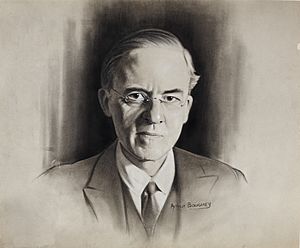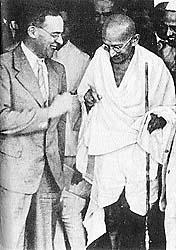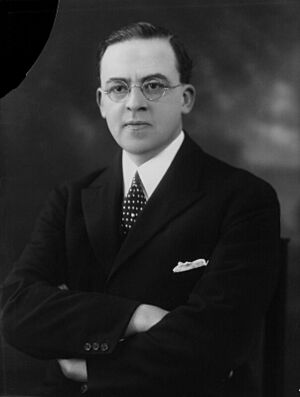Stafford Cripps facts for kids
Quick facts for kids
Stafford Cripps
|
|
|---|---|
 |
|
| Chancellor of the Exchequer | |
| In office 13 November 1947 – 19 October 1950 |
|
| Prime Minister | Clement Attlee |
| Preceded by | Hugh Dalton |
| Succeeded by | Hugh Gaitskell |
| Minister for Economic Affairs | |
| In office 29 September 1947 – 13 November 1947 |
|
| Prime Minister | Clement Attlee |
| Preceded by | New creation |
| Succeeded by | Post abolished (Trial post) |
| President of the Board of Trade | |
| In office 27 July 1945 – 29 September 1947 |
|
| Prime Minister | Clement Attlee |
| Preceded by | Oliver Lyttelton |
| Succeeded by | Harold Wilson |
| Minister of Aircraft Production | |
| In office 22 November 1942 – 25 May 1945 |
|
| Prime Minister | Winston Churchill |
| Preceded by | John Llewellin |
| Succeeded by | Ernest Brown |
| Leader of the House of Commons Lord Privy Seal |
|
| In office 19 February 1942 – 22 November 1942 |
|
| Prime Minister | Winston Churchill |
| Preceded by | Winston Churchill (as Leader of the House of Commons) Clement Attlee (as Lord Privy Seal) |
| Succeeded by | Anthony Eden (as Leader of the House of Commons) Robert Gascoyne-Cecil (as Lord Privy Seal) |
| Solicitor General for England and Wales | |
| In office 22 October 1930 – 24 August 1931 |
|
| Prime Minister | James Ramsay MacDonald |
| Preceded by | James Melville |
| Succeeded by | Thomas Inskip |
| Member of Parliament for Bristol South East Bristol East (1931–1950) |
|
| In office 16 January 1931 – 25 October 1950 |
|
| Preceded by | Walter John Baker |
| Succeeded by | Tony Benn |
| Personal details | |
| Born |
Richard Stafford Cripps
24 April 1889 Chelsea London, England |
| Died | 21 April 1952 (aged 62) Zurich, Switzerland |
| Political party | Labour |
| Spouse | Dame Isobel Cripps |
| Children | 4, including Peggy Cripps |
| Parents | Charles Cripps Theresa Potter |
| Relatives | Charlotte Thomas Kwame Anthony Appiah (grandson) |
| Alma mater | University College London |
Sir Richard Stafford Cripps (born April 24, 1889 – died April 21, 1952) was an important British politician. He was a member of the Labour Party, a skilled lawyer, and a diplomat.
Cripps came from a wealthy family of lawyers. He first became a Member of Parliament (MP) in 1931. He was one of the few Labour politicians who kept their seat in the election that year. He became a strong voice for the left-wing of his party. Before 1939, he supported working with Communists, which led to him being removed from the Labour Party.
During World War II, Cripps served as the British Ambassador to the Soviet Union from 1940 to 1942. He became very popular in Britain. In 1942, he joined the War Cabinet, a group of top government leaders. He tried to solve problems in India but his ideas were not accepted by all. Later, he was the Minister of Aircraft Production, a key role during the war.
Cripps rejoined the Labour Party in 1945. After the war, he served in the government led by Clement Attlee. He was first the President of the Board of Trade. From 1947 to 1950, he was the Chancellor of the Exchequer, which means he was in charge of the country's money. Many people believed he helped improve Britain's economy after the war.
The British economy started to get better after 1947, partly thanks to money from the Marshall Plan from the United States. However, the value of the British pound had to be lowered in 1949. Cripps kept wartime rationing in place to control spending. He also encouraged exports and tried to keep everyone employed without wages rising too fast. People respected him for his honesty and strong principles.
Contents
Early Life and Education
Cripps was born in Chelsea, London. His father, Charles Cripps, was a lawyer and later a politician. Stafford Cripps grew up in a rich family. He went to Winchester College and then studied chemistry at University College London.
He later decided to study law. In 1913, he became a lawyer. During World War I, he drove an ambulance in France. He also managed a factory that made weapons. In the 1920s, he became a very successful lawyer, specializing in cases about new inventions (patents). He was known as one of the highest-paid lawyers in England. In 1927, he became a King's Counsel, a special title for top lawyers.
Cripps was a member of the Church of England. In the 1920s, he became a leader in a group that promoted international friendship through churches.
Joining Politics and the Labour Party
In the late 1920s, Cripps' political ideas became more left-wing. He joined the Labour Party in 1930. The next year, he became the Solicitor General for England and Wales, a senior legal role in the government. He was also knighted, which was common for people in that position.
In 1931, Cripps was elected as an MP for Bristol East. In Parliament, he supported strong socialist ideas about how society and the economy should work. However, he was also a devout Christian and did not agree with the idea that religion should be rejected.
In the 1931 general election, Cripps was one of only three Labour ministers who kept their seats. The others were George Lansbury and Clement Attlee.
In 1932, Cripps helped start the Socialist League. This group believed in a strict form of democratic socialism. He suggested that if the Labour Party came to power, they should act quickly to prevent financial problems and get rid of the House of Lords.
In 1936, the Labour Party disagreed with a speech Cripps made. He had said that a German victory might not be bad for British workers. Cripps also spoke against Britain building up its military. He believed workers could stop war by refusing to make weapons.
Cripps was one of the first to suggest that different political groups should work together against the growing threat of fascism. He also opposed the policy of trying to avoid war with Nazi Germany by giving in to its demands. In 1936, he tried to create a "Unity Campaign" with other left-wing parties. The Labour Party leaders did not support this. Cripps later closed the Socialist League in 1937. The newspaper he helped start, Tribune, continued. In 1939, Cripps was removed from the Labour Party because he kept pushing for a "Popular Front" with other parties, including Communists and Liberals.
In 1938, Cripps visited Jamaica to look into violence during strikes. He spoke at meetings, and his words influenced many, including Billy Strachan, who later became a civil rights leader. The People's National Party was formed during one of these meetings.
Second World War Contributions

When Winston Churchill formed his wartime government in 1940, he made Cripps the Ambassador to the Soviet Union. Churchill thought Cripps, with his socialist views, might be able to talk to Joseph Stalin. At the time, the Soviet Union had a non-aggression pact with Nazi Germany. When Hitler attacked the Soviet Union in June 1941, Cripps became very important in forming an alliance between the Western powers and the Soviet Union.
In 1942, Cripps returned to Britain and gave a radio speech about the Soviet war effort. People loved it, and Cripps quickly became one of the most popular politicians. He was appointed to the War Cabinet as Lord Privy Seal and Leader of the House of Commons. For a short time, some even saw him as a possible rival to Churchill.
Mission to India

Churchill sent Cripps to India on a special mission. He was to negotiate an agreement with Indian leaders. The goal was to keep India supporting the British war effort in exchange for self-government after the war. Cripps created the proposals himself. However, his ideas were too radical for Churchill and the British leaders in India. They were also too conservative for Mahatma Gandhi and other Indian leaders, who wanted immediate independence. No agreement was reached, and the mission failed.
Minister of Aircraft Production
In November 1942, Cripps left his role as Leader of the House of Commons. He was appointed Minister of Aircraft Production. This job was outside the main War Cabinet, but he did it very well until May 1945. Cripps supported bombing campaigns against Germany. In 1943, he said that destroying German factories and transport from the air would weaken their resistance and reduce British casualties.
Cripps was not happy with some of the British propaganda against Germany. When he learned about certain radio broadcasts, he wrote to the Foreign Secretary, saying he would rather lose the war than use such methods.
In February 1945, Cripps rejoined the Labour Party.
After the War and Economic Leadership
When Labour won the 1945 general election, Clement Attlee made Cripps President of the Board of Trade. This was the second most important economic job in the government. Even though he was still a strong socialist, Cripps had changed his views enough to work well with other Labour ministers.
After the war, Britain faced tough economic times. Cripps became known for his policy of "austerity." This meant strict controls on spending and resources. As a socialist from a wealthy background, he believed in fairness and applied rationing equally to everyone. He also helped set up the College of Aeronautics, which is now Cranfield University. A building there is named after him.
In 1946, Soviet engineers wanted to buy jet engine designs from Western countries. Cripps and the Labour government agreed to provide technical information about the Rolls-Royce Nene jet engine. The Soviets then copied and improved this engine, creating the Klimov VK-1. This engine was later used in the MiG-15 fighter jets during the Korean War.
Also in 1946, Cripps went back to India as part of the "Cabinet Mission." This mission suggested plans for India's independence. However, the plan was not fully accepted by the Indian leaders. This led to further discussions that eventually resulted in the division of India.
In 1947, Britain faced a growing economic crisis. Cripps tried to convince Attlee to let Ernest Bevin become Prime Minister. Instead, Cripps was given a new job as Minister for Economic Affairs. Six weeks later, he became Chancellor of the Exchequer, taking on both roles. He increased taxes and continued rationing to boost trade and stabilize the British currency. He also helped bring about the nationalisation of important industries like coal and steel.
From 1948 to 1949, despite financial problems, Cripps made sure the government continued to spend money on housing, health, and other welfare services. People's incomes and free time continued to grow. In his last budget as Chancellor in 1950, he increased the number of new houses built. He also lowered income tax for low-income earners and increased spending on health and education.
Cripps had suffered for many years from colitis, a bowel condition made worse by stress. In 1950, his health failed, and he had to resign from his job in October. He also left Parliament that month. Tony Benn succeeded him as the MP for Bristol South East.
Family Life
Cripps was related to Beatrice Webb and Catherine Courtney. His mother died when he was four. His stepmother, Marian Ellis, had a big influence on him. He was married to Isobel Swithinbank, who became Dame Isobel Cripps. They had four children:
- Sir John Stafford Cripps (1912–1993), a journalist.
- Isobel Diana Cripps (1913–1985).
- (Anne) Theresa Cripps (1919–1998).
- Peggy Cripps (1921–2006), a children's author. Peggy married Nana Joseph Emmanuel Appiah, an African aristocrat from Ghana. This marriage caused some surprise in Britain at the time. Peggy and Joe had one son and three daughters. Their son is the famous philosopher Kwame Anthony Appiah.
Cripps was a vegetarian. This was partly for health reasons, as it helped with his illness. In 1989, a special plaque was placed at his birth home in Chelsea, London.
Death
Cripps died from cancer on April 21, 1952, at the age of 62, in Zürich, Switzerland. He was cremated there. His ashes are buried in the churchyard in Sapperton, Gloucestershire, next to his wife.
See also
- List of ambulance drivers during World War I
- Cripps question (patent law)


